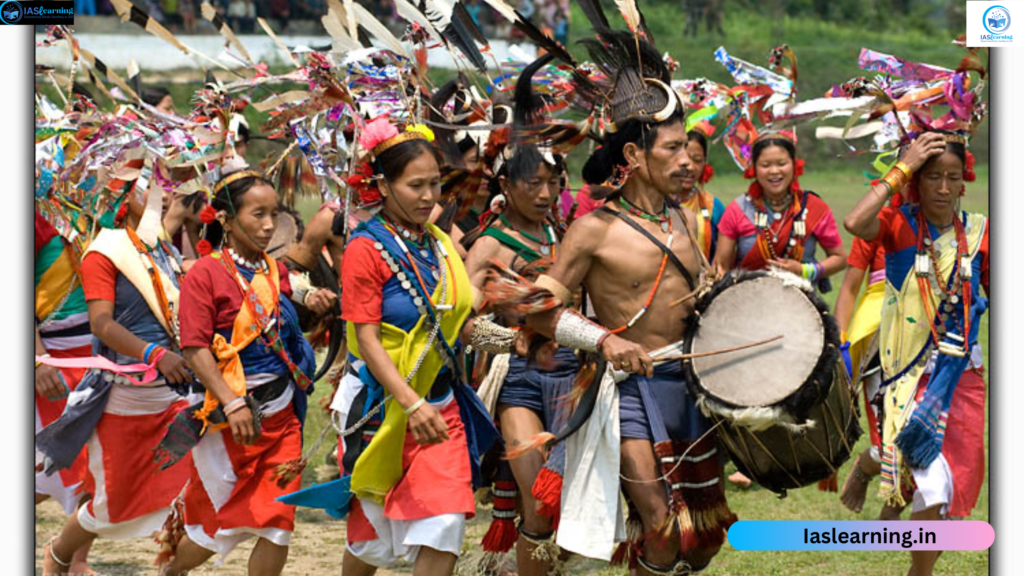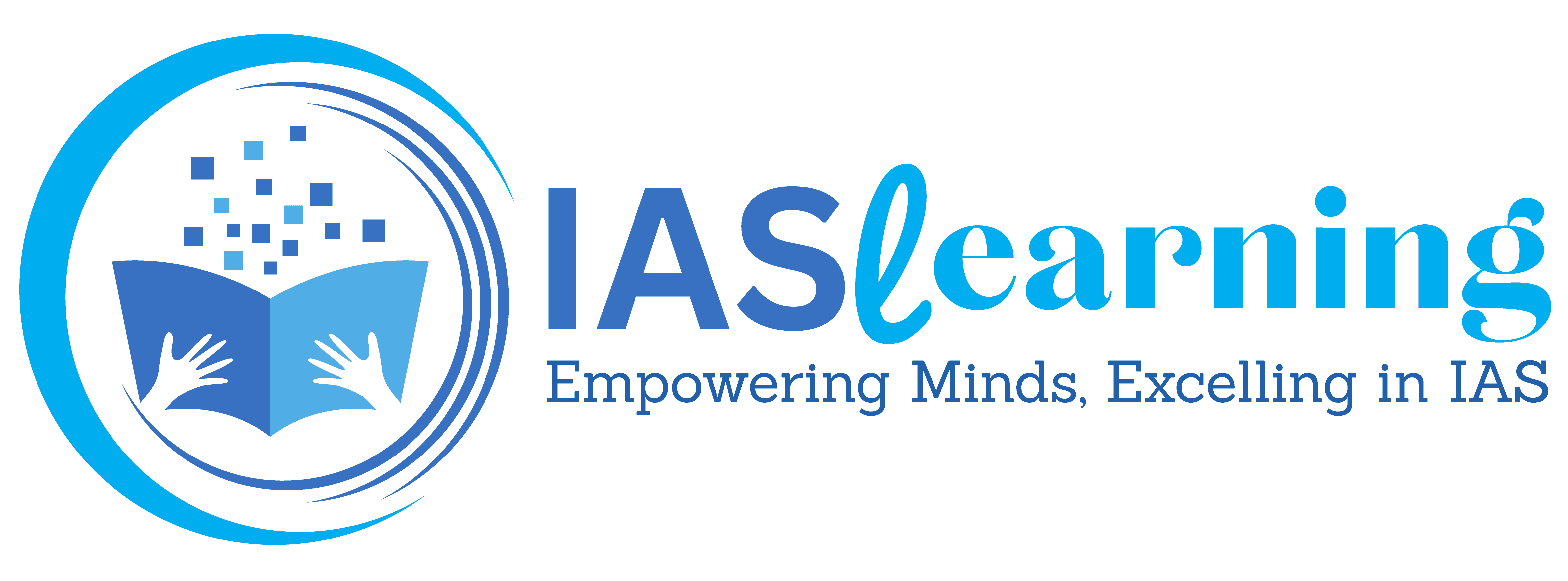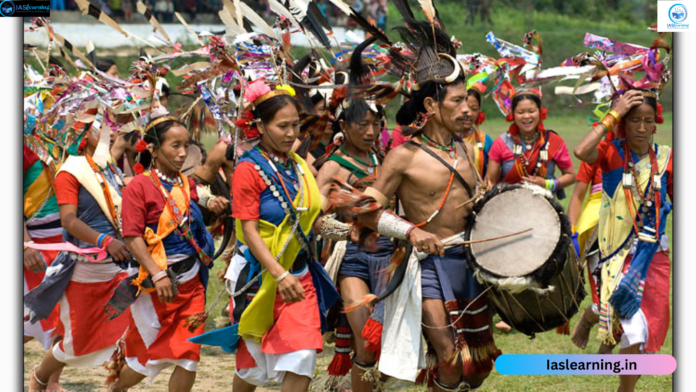What is the status of tribal communities in India?
| Indicator | Data |
| Tribal population | According to the 2011 census, the tribal population in India was 104 million, constituting 8.6 per cent of country’s population. |
| Sex ratio | The sex ratio of the tribal population in the country is higher than the national average at 990 females per 1,000 males. The child sex ratio has declined from 972 in 2001 to 957 in 2011, the first ever report on health of tribals has revealed. |
| Per capita income | As per the estimates of poverty ratio of the Planning Commission, the percentage of STs living below the poverty line has come down from 62.3% in rural areas during 2004-05 to 45.3% during 2011-12. In the urban areas, the percentage of STs living below the poverty line has come down from 35.5% during 2004-05 to 24.1% during 2011-12. |
| Literacy rate | The literacy rate of scheduled tribe in India is 58.96 percent as compared to the National average i.e. 72.99 percent. |
| Health indicator | 65% of tribal women in the 15-49 years age group suffer from anemia.The rate of institutional delivery is the lowest among tribal women (70.1%).Total Fertility Rate for STs is 2.5. |
What are major problems faced by the tribal communities in India?
Tribals in India face a wide range of problems, some of which are:
| Problems | Description | Examples |
| Land rights and displacement | Many tribal communities have been displaced from their traditional lands due to development projects, mining, and other activities. This has led to losing their livelihoods, homes, and cultural heritage. | Sardar Sarovar Dam in Gujarat has displaced thousands of tribal people from their ancestral lands. |
| Exploitation and marginalization | They are often exploited and marginalized by powerful groups, such as government officials, landlords, and businessmen. | Adivasi population in the state of Odisha have been facing exploitation by the mining companies, who have taken over their land and resources. |
| Lack of education and healthcare | They have limited access to education and healthcare, which has a negative impact on their overall well-being and development.Lot of health issues, such as malnutrition, lack of access to proper health care, and a high incidence of infectious diseases. | The literacy rate among the tribal population is lower compared to the national average and the healthcare facilities in tribal areas are inadequate.As per census 2011 the literacy rate was 59%. |
| Loss of culture and tradition | Lost their traditional customs, languages, and arts due to modernization and the erosion of their traditional way of life. | Due to impact of globalization and modernization traditional practices and rituals of the Great Andamanese tribes are on the verge of extinction. |
| Economic marginalization | Engaged in traditional forms of livelihoods, such as agriculture, forestry, and hunting, which are becoming less viable in the face of modernization and globalization. | The traditional livelihoods of the Munda tribes in Jharkhand are under threat due to the decline in the availability of forest resources and the impact of mining. |
| Political marginalization | They are not well represented in the political process and their voices are not heard in the policy-making process. | Tribal communities of the Northeast region of India have not had a fair representation in the political process and their issues are not fully addressed by the government. |
For more : Evolution of Judiciary During British Times
Indian Renaissance Short Notes
What are the constitutional provisions for the welfare of the tribal communities in India?
| Article | Provisions |
| Article 15(4) and 16(4) | Reservation of seats in educational institutions and government jobs for Scheduled Castes and Scheduled Tribes to help them overcome historical disadvantages and improve their socio-economic status. |
| Article 46 | Lays down the directive principles of the State Policy which require the State to promote the educational and economic interests of the Scheduled Castes and Scheduled Tribes, and to protect them from social injustice and all forms of exploitation. |
| Article 244 | Administering tribal areas in certain states, such as Assam, Meghalaya, Tripura, and Mizoram, under the Fifth and Sixth Schedules of the Constitution. |
| Article 275 | Financial assistance to the states for the welfare of Scheduled Castes and Scheduled Tribes. |
| Article 330 | Reserving seats in the House of the People and the Legislative Assemblies of the States for Scheduled Castes and Scheduled Tribes. |
| Article 332 | Reservation of seats for Scheduled Castes and Scheduled Tribes in the Legislative Councils of the States where such Councils exist. |
| Article 338 | Constitution of a National Commission for Scheduled Castes and Scheduled Tribes to investigate and monitor the implementation of laws and policies related to the welfare of Scheduled Castes and Scheduled Tribes. |

What are the laws for the welfare of tribal communities?
- PANSA, or the Panchayats (Extension to Scheduled Areas) Act of 1996:
- This statute gives gram sabhas (village councils), where indigenous people make up the bulk of the population, more authority and responsibility.
- As a result, tribal people have greater autonomy over their own concerns and may actively engage in the process of development.
- Act of 2004 Establishing a National Commission for Scheduled Tribes
- The National Commission for Scheduled Tribes (NCST) would be established under this legislation in order to look into and oversee the application of laws and regulations pertaining to the welfare of scheduled tribes.
- The Forest Rights Act of 2006:
- This law protects the rights of indigenous people who live in forests to access and utilize forest resources, such as land.
- It seeks to maintain these communities’ livelihoods and general well-being while also making amends for the past injustices these people have endured.
- The Land Acquisition Act of 2013:
- This law allows for the purchase of property for the benefit of Native Americans. It also mandates the rehabilitation and resettlement of displaced individuals as well as the approval of the Native Americans.
What are government initiatives in the interest of tribal communities?
- Eklavya Model Residential Schools (EMRS) were established to offer ST kids (Class VI–XII) in rural locations a high-quality education through residential schooling facilities.
- Pradhan Mantri Vanbandhu Vikas Yojana: To encourage youngsters from ST communities to create their own businesses, a venture capital fund has been established.
- Pradhan Mantri Jan Jatiya Vikas Mission: Mantri Pradhan The mission of Jan Jatiya Vikas is to encourage the marketing of tribal goods and guarantee the Minimum encourage Price (MSP) for minor forest products.
- The Indian tribal groups’ efforts to enhance their means of subsistence through retail selling are supported by the Tribal Cooperative selling Development Federation of India (TRIFED). This includes the Van Dhan Yojana (VDY), which is implemented in 340 districts nationwide and has over nine lakh beneficiaries.
- The PMAAGY, or Pradhan Mantri Adi Adarsh Gram Yojana, Its goal is to supply communities with a sizable indigenous population with the necessities of life.
- Tribal Sub-Plan:
- A unique development programme for the welfare of tribal people, the Tribal Sub-Plan (TSP) was launched by the Indian government.
- The program seeks to enhance the socioeconomic standing of indigenous people while attending to their unique requirements.
- Special Central Assistance:
- For the benefit of tribal people, State Governments in India get Special Central Assistance (SCA) from the Central Government of India.
For more : Ahmedabad Mill Strike: First Hunger Strike,1918
What could be done to further improve the well-being of tribal communities in India?
Improving the quality of life for Indian tribal groups would necessitate a comprehensive and all-encompassing strategy that tackles the various interrelated problems they encounter. Several more possible courses of action include
- Sustainable development: Tribal groups’ needs and concerns should be given priority while planning and carrying out development initiatives.
- Education accessibility: More should be done to guarantee that students from indigenous communities have access to high-quality primary, secondary, and vocational education.
- Health Care: The tribes should have better access to high-quality healthcare services. This entails offering maternity and pediatric healthcare services, general healthcare, and facilitating easier access to necessary medications.
- Empowerment of tribal women: The general well-being of the tribes depends on the empowerment of tribal women. This entails giving them chances for education and skill development, as well as assuring their involvement in decision-making.
- Promotion of livelihoods: Tribal people should be given more support in order to build sustainable livelihoods. This entails giving them access to financing, marketing resources, and instruction in contemporary farming methods.
- Land rights: Tribal peoples have rights to their land that have to be respected and safeguarded. This entails giving them a title to their land legally and making sure they are not uprooted from it.
For more : Role & Responsibility of Speaker




